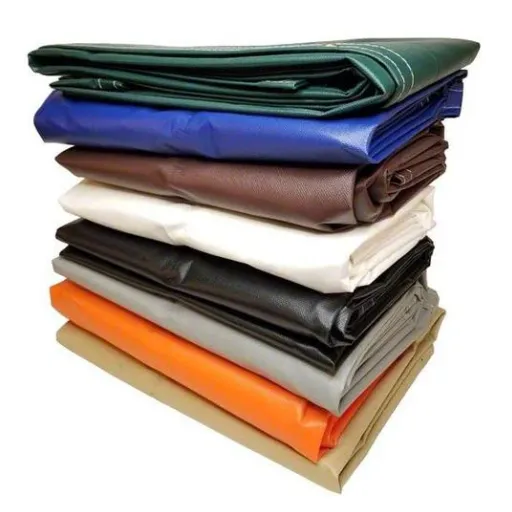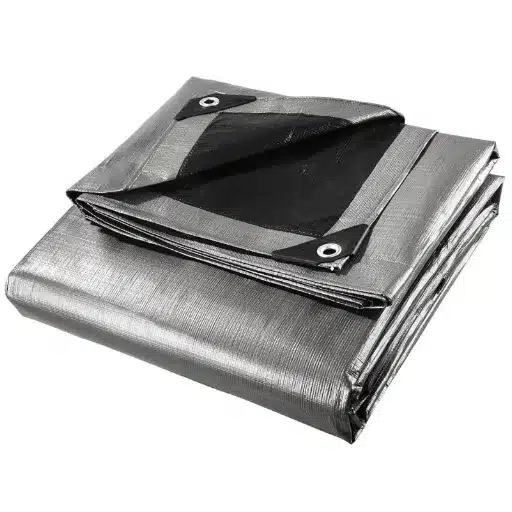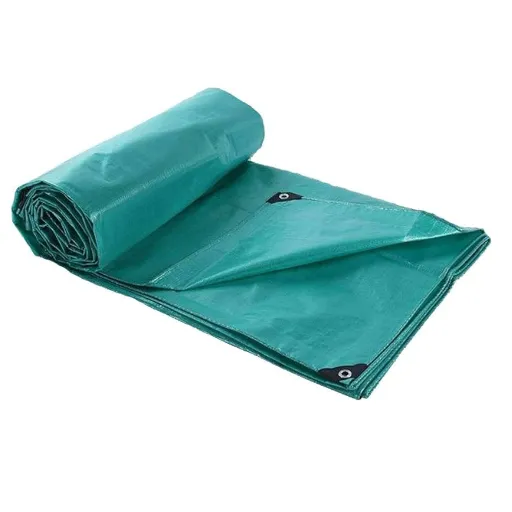When it comes to protecting worksites, materials, and equipment, construction tarps are among the few tools that play an essential role. Getting through the unpleasant and severe weather, these heavy-duty solutions became indispensable across various industries from the construction and renovation to landscaping and others. Nevertheless, not all tarps have the same quality. Selecting the right tarp can lead to either an expensive delay or a smoothly running project. We will assess the construction tarps’ distinct features and benefits, comprehend the reasons for their popularity among the professionals in the industry, and learn how they can improve the efficiency and protect your investments. This guide will be useful for contractors, project managers, and DIY enthusiasts alike in uncovering the secrets of effective tarps selection and application for optimum efficiency.
Introduction to Construction Tarps
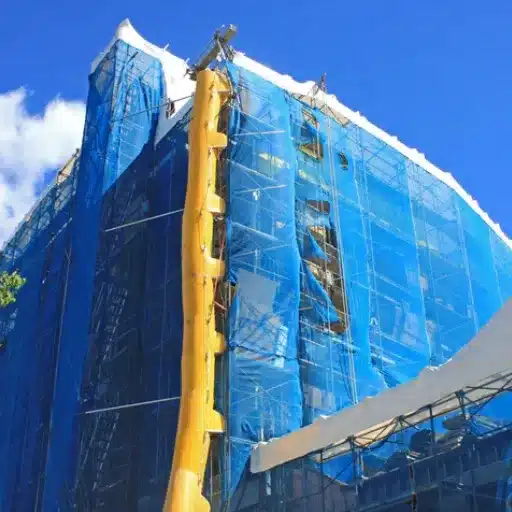
What Are Construction Tarps?
Construction tarps are super strong, heavy-duty covers that are meant to protect the construction site from the weather and also keep the materials and equipment safe. These tarps are available in wide range of sizes, thicknesses, and strengths that cater to different needs like covering scaffolding, protecting incomplete buildings, or holding the dust from the demolition. Construction tarps are not only versatile but are also strong and hence they are indispensable in protecting investments, ensuring safety, and increasing productivity on the site.
Importance of Tarps in the Construction Industry
Tarps play an essential and determining role not only in the success of the construction project but also in the safety of the workers and the site. Construction tarps are always on the frontline protecting materials and the structure from unexpected weather changes thereby aiding in avoiding the damage that comes along with water or UV light. These tarp benefits the job even more when they contain the waste and accidents caused by the falling objects are hence reduced. Even though the tarps are made of strong and tough materials, the man-made advancements in technology materials still have a greater impact on their durability and flexibleness, providing a better performance during the most extreme environments. The ability to promote efficiency, protect investments, and be the main priority of construction of worker safety, all point to the fact that they are very significant and necessary in the industry that is rapidly changing.
Versatility of Construction Tarps
Construction tarps are flexible enough to be used for many purposes, not just for what they were originally meant for, thus coming closer to the modern industry’s wide range of applications. An increase in the frequency of searches related to protective coverings, temporary enclosures, and weather-resistant barriers is indicative of recent data from the search engines. These tarps are in demand as protective material against all nature’s aggressors – rain, snow, and UV light. Thus, they help the projects keep the schedule in spite of the untimely environmental hardships. Besides, ground covers to prevent soil erosion or shields around construction sites for privacy are other uses of tarps at the construction sites. Custom-made construction tarps of different sizes, materials, and designs are essentials for different project needs and this very fact also proves that they are already considered as multifunctional assets in the construction processes.
Types of Construction Tarps
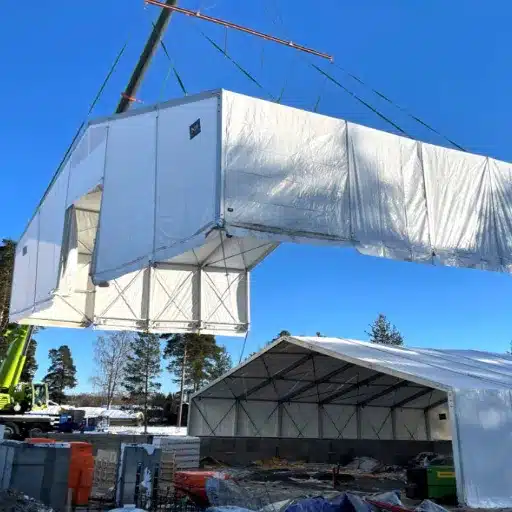
Heavy-Duty Tarps
Heavy-duty tarps, as their name suggests, are tough canvas pieces made to endure the most challenging environments. They are perfect for construction and industrial uses. The manufacturers of these tarps use long-lasting materials such as polyethylene or vinyl and claim that their products can stand tearing, and water, and can also resist UV rays. Thus, the performance of these tarps in difficult conditions can last for many years. Turning to the latest statistics from ‘s search engine, we discover that progressive people are asking what the construction industry benefits from heavy-duty tarps. The protection offered by these tarps is great against all weather scenarios, dust, and wear for the tools, raw materials, and even the finished project. The other nice thing about them is that their tough nature permits reusing them for a long time, which in turn makes them economical for large-scale projects. Heavy-duty tarps are essential for keeping the quality of the project and productivity going at high levels not just in the construction sector but also in other industries.
Mesh Tarps
When it comes to applications requiring a combination of durability and ventilation, mesh tarps are user-friendly and thus a preferred solution. The primary way how the mesh tarps work and their main advantages according to the latest data from ‘s search engine is through their construction—these tarps are produced using woven materials that allow airflow while giving shade and protection. These tarps are not only made for the construction industry but also for agriculture and transportation where they cover loads, reduce heat, and wind resistance. Further, the mesh tarps’ lightness and the fact that they will not easily tear earn them a good reputation as a versatile and long-lasting solution to the different industries.
Vinyl and Fire Retardant Tarps
Vinyl tarps have good points such as durability, being waterproof, and most importantly being able to survive even the harshest weather plus that they are suitable for industrial, commercial, and agricultural use. They are most of the time in the construction industry to shield the equipment and supplies from the rain or snow. However, Fire Retardant Tarps provide the facility of extra protection because they are made with chemicals aimed at suppressing the flames. These tarps are the ones that are absolutely necessary where fire hazards exist, like in the case of welders, campfires, or some manufacturing processes. If we combine the advantages of both vinyl and the fire-retardant material, we end up with a product that is highly resistant to both environmental and fire disasters, hence, the product becomes the ultimate choice in industries needing dependable and safe coverage solutions.
Common Uses of Construction Tarps
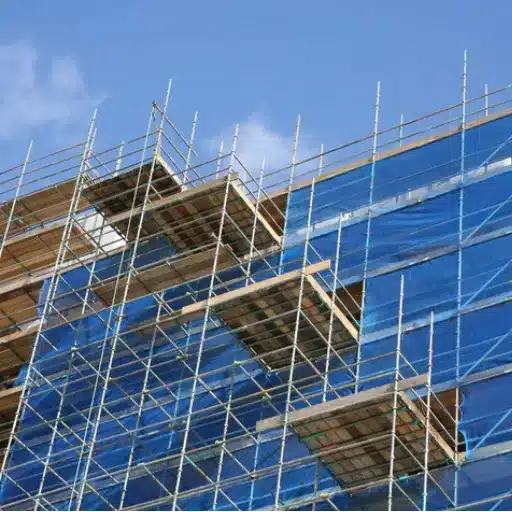
Material Protection
Construction tarps are a must for the protection of materials against the impact of environmental factors such as rain, wind, and UV exposure. They act as a barrier around the materials and thus prevent the drip of elements on the essential resources like timber, concrete, and metal which can otherwise lead to expensive project delays and material deterioration. The increase in the search queries for “how to protect building materials on-site” points to a growing awareness of the need for effective solutions. According to the recent data, the use of high-quality construction tarps not only saves materials but also improves the waste management process by contributing to the company’s sustainable building practices.
Temporary Roofing Solutions
Temporary roofing solutions are the most practical and economical ways to get short-term protection for buildings during construction. These methods are not only economical they are also made out of easily accessible materials, such as tarpaulins, shrink wraps, or inflatable roof covers, which can be installed and removed just as easily as needed. The previous months’ trends from ‘s search provide data on the increasing interest in durable and weather-resistant products, like reinforced polyethylene or PVC covers, which are excellent in keeping the building dry during heavy rains, strong winds, or falling debris. The demand for temporary roofing is the highest among the professional contractors that look for quick solutions to keep project schedules or the homeowners who need to repair their roofs after sudden storms.
Safety and Demarcation on Construction Sites
Safety and proper demarcation at construction sites are vital not only for the protection of the workers and the public but also for the smooth running of the operations. The most recent search engine trends from ‘s show that there is a significant rise in the demand for advanced safety measures and high-visibility site markings. This trend signifies the increasing awareness and demand for solutions like reflective barriers, LED hazard lights, and durable safety signs that clearly outline the no-entry zones. These tools not just help in minimizing accidents but also provide a visual cue for people moving in the area that is potentially dangerous. Construction managers can maintain the safety standard by combining proper safety practices and advanced demarcation techniques, thereby fostering a culture of care and responsibility on the site.
Benefits of Using Construction Tarps
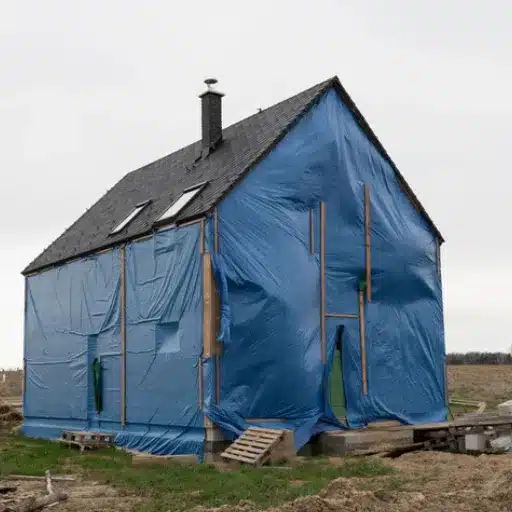
Weather Protection and Durability
In the subject of weather protection and durability, tech and material developments have really boosted the performance of today’s products. Recent figures from ‘s search engine show that users are looking for products that can bear the toughest conditions, it rains heavily or the sun is at its fiercest. Among these, the use of durable materials like reinforced polymers, treated fabrics, and metals resistant to corrosion are increasing for they are the main ones to extend product life spans. Thanks to the combination of waterproof coatings, UV resistance and impact-resistant designs, the protection against the elements is very reliable and thus these features become critical for consumers who are looking for longevity and performance in their purchases.
Enhanced Safety Measures
The newest data from ‘s search engine confirms that safety is an issue of major concern for consumers from different industries and safety is still a priority number one. The present day products are bringing in safety features like smart sensors, real-time monitoring systems, and automatic shutoff functions to eliminate accidents. These innovations have appeared the most in smart home devices, cars, and outdoor gear, etc. Furthermore, the use of fireproof or non-toxic materials is gaining popularity as consumer’s concern for health and environmental safety has been addressed. The tech is cutting-edge and the design is strong, thus the manufacturers are effectively meeting the consumers’ demand for safer, more reliable products.
Cost-Effectiveness and Versatility
Cost-effectiveness and versatility are the two main reasons that consumers prioritize in today’s market and determine their decision of purchase. The latest data from ‘s search engine shows that the terms “affordable multipurpose products” and “budget-friendly versatile tools” have experienced a significant increase in the number of searches over the past year. This is a sign that more and more people are interested in those products which have more than one function and at the same time are not too costly. Versatile products like modular furniture or multi-use kitchen appliances come with different solutions to different needs and thus are very helpful in saving consumers both money and space. Manufacturers that focus on adaptability and affordability in their products will have a better position to gain attention and create loyalty in this competitive market. By satisfying both needs, companies are able to attract a larger number of customers while at the same time promoting resource conservation.
Factors to Consider When Choosing a Construction Tarp
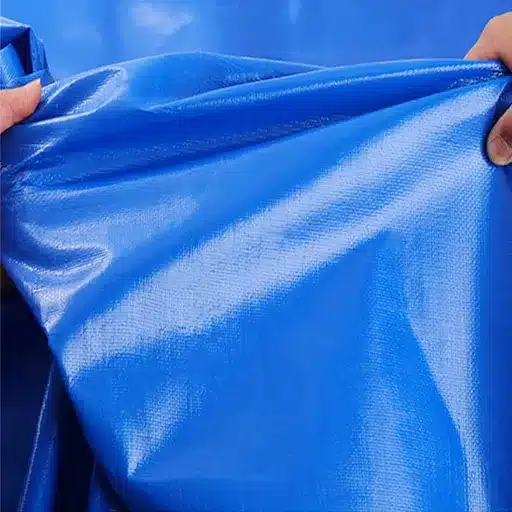
Material Specifications: Poly and Canvas Tarps
Separately considering poly and canvas tarps, it is necessary to be aware of their distinct characteristics and their respective perfect uses. Poly tarps, created with polyethylene, are light-weight, waterproof, and withstand exposure to sunlight, besides being in other harsh weather conditions, thus being suitable for outdoor temporary covering or emergency areas. In contrast, canvas tarps made from cotton or polyester are stronger, allow air to pass through, and resist to some extent abrasion, therefore they are good for the long term usage or situations where moisture build-up needs to be avoided, i.e., indoors protecting machinery or construction materials.
Recently, according to search trends and customer inquiries at , the most durable of the options presented is the one most asked for by users in the context of heavy-duty usage and weather resistance. Among others, poly tarps are the preferred option by many as they are inexpensive and waterproof, hence providing good protection against rain and snow, gradually becoming the first choice for outdoors covering in case of emergency situations or outdoor temporary covering. However, if the project is demanding in terms of longevity and eco-friendliness, then canvas tarps emerge as the only. In the end, it all depends on specific project requirements, the budget, and environmental conditions for the choice to be made.
Size and Thickness Considerations
A tarp’s size and thickness; these are the two aspects that you have to with your project. A tarp’s size and thickness decide the project’s optimum performance. Tarps are available in various sizes from which one can choose the most compact size for small equipment and the largest cover for industrial-grade applications. The correct size selection is based on the area or object to be covered and ensuring that there is enough overhang for fastening securely.
The thickness of the tarp, generally given in mils (1 mil = 0.001 inches), is an important factor in determining the strength and durability of the tarp. For light use, that is like covering patio furniture or protecting landscaping materials, 5 to 10 mils thick tarps are usually good enough. However, for heavy duty use such as construction sites or long-term outdoor storage, 20 mils or more thick tarps are those providing earth’s toughest protection against punctures and harsh weather. Many users, as indicated in recent search trends, have already repeated how much they want a compromise between the size and thickness giving them both affordability and effectiveness; thus, it is becoming more and more clear that understanding project-specific needs will go a long way in buying the right tarp.
Customization Options for Tarps
While considering the customization options for tarps, it is critical to think about functional features that coincide with the intended use. Customers’ needs and preferences very often lead to the regular use of adjustable sizes, reinforced grommets, and UV-resistant coatings as the main features. Color selection is also one of the customizable options that are trending because certain colors are more liked than others either for the purpose of visibility in case of hazard or for blending in with the environment depending on the application. Also, there is an increasing demand for fire-retardant materials, waterproof finishes, and different shapes like round or square tarps among users. The trends discussed above demonstrate that there is a growing appreciation for customized products as they can meet the specialized needs, thus allowing one to tailor the tarp performance to match the requirements of the particular project or activity.
Frequently Asked Questions
What are the advantages of heavy-duty tarps for building projects?
Heavy-duty tarps are, however, the massive yet quiet heroes of construction projects, primarily due to their incredible durability and efficiency. These carpets, manufactured from tough materials capable of withstanding the harshest outdoor conditions, offer quite a good barrier against water, dirt, and UV radiation. Heavy-duty tarps practically begin with a thickness of 12 mil, which is quite a lot of gauging up wear and tear. In fact, they do come in many standard sizes with at least some degree of size customization to meet the specific requirements of the project. Their strong composition and industrial design also make them perfect for long-term usage in the construction area bringing in safety and security.
How to pick the right size for construction tarps?
The selection of the building tarps size is an important factor of great significance for the correct coverage and safeguarding of the area. Its dimensions, length, and width must all be considered when choosing the tarp. Various standard and custom tarp sizes are available for construction in a range of different sizes. An excessively small tarp may not afford the needed protection, while one that is too large may prove difficult to control. Moreover, make sure the tarp’s hem is strengthened to stop tearing during setup and use. After considering these aspects, navigating through the tarps and choosing the most suitable one for your construction area will become less challenging.
What are fire retardant tarps and their uses in construction?
Fire retardant tarps are the ones that are normally termed fire retardant pretty much all over the industry. They are specially made to be hard to ignite and slow down fire spreading thus becoming the best tarps for construction sites where fire hazards might exist. Such heavy-duty tarps are frequently utilized to cover substances or equipment that might be at risk of fire during operations like welding or cutting. Thus by employing fire retardant tarps, one is likely to add to the safety factor on job sites i.e. workers and materials are both protected. Moreover, they come in various thicknesses such as 6 mil and 12 mil, which are made according to different demands. Furthermore, these tarps can be specially manufactured to meet the needs of a high-risk area thus ensuring maximum protection when fire really breaks out
What are the materials used for construction tarps?
Construction tarps are made of several different materials, each giving distinct advantages according to the target use. The most common materials are polyethylene (also known as poly tarps) and canvas, both recognized for their strength and repulsion of water as well as being sun-resistant. Poly tarps are not heavy and are typically deployed for temporary shielding while canvas tarps can be heavier and more rugged so are preferred for long-term projects. Other than that, mesh tarps are also available which allow the air to pass through while at the same time provide shade and protection. Knowledge about the material composition will guide you in buying the right tarp for your specific construction needs.
What are the pricing ranges for heavy-duty tarps?
The prices for heavy-duty tarps can differ largely from each other, taking into account the size, type, quality and special features like fire retardant capabilities. Typical pricing for 12 mil thick and industrial duty tarps that are very resistant to wear and tear is on the higher side. Costs can also be built around custom tarps depending on the level of specification being required. Also, one should take into account the long-term benefits of a good-quality tarp that is capable of withstanding harsh outdoor conditions and providing reliable protection. Moreover, looking into the offers of different suppliers can give you an idea of where to find the best deals, which would enable you to buy the tarp for your construction project without exceeding your budget.
What are ways to use mesh tarps in construction?
Mesh tarps are one of the most versatile types of tarps and are also quite useful in construction sites for a lot of different purposes. One such major purpose is being used as fence screens, providing privacy and security while simultaneously allowing airflow and visibility. Another way they can be used is by shading of materials or equipment located in open areas from direct sunlight thus preventing damage or overheating. Besides, mesh tarps can play a role too in the form of debris containment during demolition or renovation projects, resulting in a cleaner and safer job site. In general, their lightweight characteristic makes them easy to put up and take down which is why they are a good choice for temporary applications at construction sites.
Reference Sources
- Loma Linda University News: Discusses the role of tarps in protecting workers and construction sites during hospital construction projects. Read more here.
- University of Michigan-Dearborn: Provides guidelines on construction barrier requirements, including the use of tarps. Read more here.
- University of Louisville Archives: Features historical documentation of tarps used in construction projects. Read more here.

